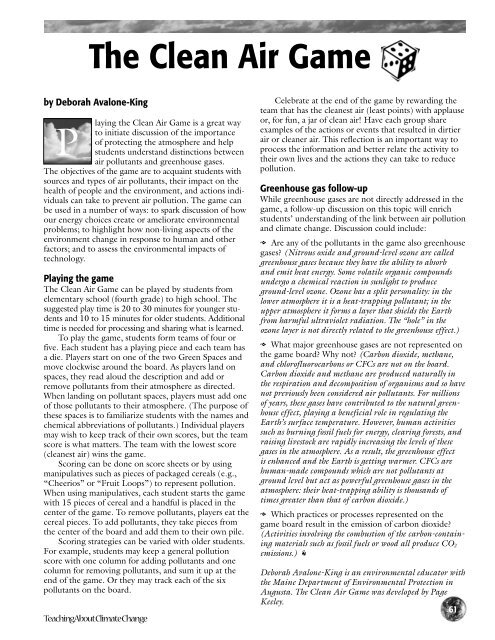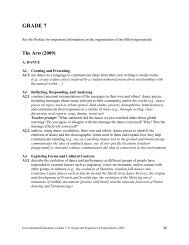The Clean Air Game
The Clean Air Game
The Clean Air Game
You also want an ePaper? Increase the reach of your titles
YUMPU automatically turns print PDFs into web optimized ePapers that Google loves.
<strong>The</strong> <strong>Clean</strong> <strong>Air</strong> <strong>Game</strong>by Deborah Avalone-Kinglaying the <strong>Clean</strong> <strong>Air</strong> <strong>Game</strong> is a great wayPto initiate discussion of the importanceof protecting the atmosphere and helpstudents understand distinctions betweenair pollutants and greenhouse gases.<strong>The</strong> objectives of the game are to acquaint students withsources and types of air pollutants, their impact on thehealth of people and the environment, and actions individualscan take to prevent air pollution. <strong>The</strong> game canbe used in a number of ways: to spark discussion of howour energy choices create or ameliorate environmentalproblems; to highlight how non-living aspects of theenvironment change in response to human and otherfactors; and to assess the environmental impacts oftechnology.Playing the game<strong>The</strong> <strong>Clean</strong> <strong>Air</strong> <strong>Game</strong> can be played by students fromelementary school (fourth grade) to high school. <strong>The</strong>suggested play time is 20 to 30 minutes for younger studentsand 10 to 15 minutes for older students. Additionaltime is needed for processing and sharing what is learned.To play the game, students form teams of four orfive. Each student has a playing piece and each team hasa die. Players start on one of the two Green Spaces andmove clockwise around the board. As players land onspaces, they read aloud the description and add orremove pollutants from their atmosphere as directed.When landing on pollutant spaces, players must add oneof those pollutants to their atmosphere. (<strong>The</strong> purpose ofthese spaces is to familiarize students with the names andchemical abbreviations of pollutants.) Individual playersmay wish to keep track of their own scores, but the teamscore is what matters. <strong>The</strong> team with the lowest score(cleanest air) wins the game.Scoring can be done on score sheets or by usingmanipulatives such as pieces of packaged cereals (e.g.,“Cheerios” or “Fruit Loops”) to represent pollution.When using manipulatives, each student starts the gamewith 15 pieces of cereal and a handful is placed in thecenter of the game. To remove pollutants, players eat thecereal pieces. To add pollutants, they take pieces fromthe center of the board and add them to their own pile.Scoring strategies can be varied with older students.For example, students may keep a general pollutionscore with one column for adding pollutants and onecolumn for removing pollutants, and sum it up at theend of the game. Or they may track each of the sixpollutants on the board.Teaching About Climate ChangeCelebrate at the end of the game by rewarding theteam that has the cleanest air (least points) with applauseor, for fun, a jar of clean air! Have each group shareexamples of the actions or events that resulted in dirtierair or cleaner air. This reflection is an important way toprocess the information and better relate the activity totheir own lives and the actions they can take to reducepollution.Greenhouse gas follow-upWhile greenhouse gases are not directly addressed in thegame, a follow-up discussion on this topic will enrichstudents’ understanding of the link between air pollutionand climate change. Discussion could include: Are any of the pollutants in the game also greenhousegases? (Nitrous oxide and ground-level ozone are calledgreenhouse gases because they have the ability to absorband emit heat energy. Some volatile organic compoundsundergo a chemical reaction in sunlight to produceground-level ozone. Ozone has a split personality: in thelower atmosphere it is a heat-trapping pollutant; in theupper atmosphere it forms a layer that shields the Earthfrom harmful ultraviolet radiation. <strong>The</strong> “hole” in theozone layer is not directly related to the greenhouse effect.) What major greenhouse gases are not represented onthe game board? Why not? (Carbon dioxide, methane,and chlorofluorocarbons or CFCs are not on the board.Carbon dioxide and methane are produced naturally inthe respiration and decomposition of organisms and so havenot previously been considered air pollutants. For millionsof years, these gases have contributed to the natural greenhouseeffect, playing a beneficial role in regulating theEarth’s surface temperature. However, human activitiessuch as burning fossil fuels for energy, clearing forests, andraising livestock are rapidly increasing the levels of thesegases in the atmosphere. As a result, the greenhouse effectis enhanced and the Earth is getting warmer. CFCs arehuman-made compounds which are not pollutants atground level but act as powerful greenhouse gases in theatmosphere: their heat-trapping ability is thousands oftimes greater than that of carbon dioxide.) Which practices or processes represented on thegame board result in the emission of carbon dioxide?(Activities involving the combustion of the carbon-containingmaterials such as fossil fuels or wood all produce CO 2emissions.) Deborah Avalone-King is an environmental educator withthe Maine Department of Environmental Protection inAugusta. <strong>The</strong> <strong>Clean</strong> <strong>Air</strong> <strong>Game</strong> was developed by PageKeeley.61
PARTICULATEMATTER (PM)Your familyreduces theirenergy use.BREATHE THE FRESH AIRAND TAKE ANOTHER TURN.You have aheadache from COor toxic exposure.Lose one turn.Your diesel trucks needengine maintenance.Add one PM and Toxic toyour atmosphere.You burn small, hotfires with seasonedwood in yourwoodstove.Remove one PM andToxic from youratmosphere.Volcanoes, pollen, forest firesand trees add natural pollutantsto the atmosphere.Lose one turn.<strong>The</strong> <strong>Clean</strong>Start hereGREEN SPACEYou may removeany one pollutant.You are careful not to let yourcar idle for very long.Remove one CO, PM and VOCfrom your atmosphere.1. Start on a Green Space.2. Take turns rolling die and moving gamepieces. Read aloud and followinstructions on each space you land on.If you land on a pollutant space, addone of that pollutant to your score.3. Record scores on a tally sheet.4. <strong>The</strong> team or player with the lowest score(cleanest air) wins.Your woodburning stove givesoff CO, PM and Toxics.Add one of each to youratmosphere.CARBONMONOXIDE(CO)Regional windpatterns carrypollutants longdistances.Take one pollutant fromeach category and add it toyour atmosphere.You buy a newcar that uses analternative fuel oris a low emissionsvehicle.Remove one O 3 andPM from youratmosphere.You live near a metalrefinery or have foundlead paint and pipes inyour home.Add one Pbto youratmosphere.LEAD (Pb)HAZARDOAIRPOLLUTAN(HAPs oTOXICS62Home and Community
SULFURDIOXIDE(SO 2)You have a coalburningfurnace.Add one SO 2to youratmosphere.To reduce acid rain, yourlocal power plant switchesto low sulfur coal or oiland installs scrubbers toremove SO 2from yoursmokestream.Remove one SO 2fromyour atmosphere.You voice your concernsto your legislators.Every player mayremove onepollutant fromtheiratmosphere.OZONE (O 3)<strong>Air</strong> <strong>Game</strong>Every member ofyour family commutes towork alone each day.Add one ozone to youratmosphere.You ride your bike to workeach day instead of driving.Remove one ozone from youratmosphere.Start hereGREEN SPACEYou may removeany one pollutant.You can’t exercisetoday because highozone levels make itdifficult to breathe.Lose one turn.<strong>The</strong> <strong>Clean</strong> <strong>Air</strong> Act passes.andUSTSr)Your sink cabinet and garagecontain toxic cleaningsolvents and other poisonswhich increaseyour risk ofcancer.Lose one turn.You regularlyhave your cartuned up.Remove one NOxand O 3 from youratmosphere.Your local powerplant burns coal.Add one NOx to youratmosphere.BREATHE THE FRESH AIRAND TAKE ANOTHERTURN.NITROGENOXIDES andVOLATILEORGANICCOMPOUNDS(NOx andVOC)Teaching About Climate Change63





